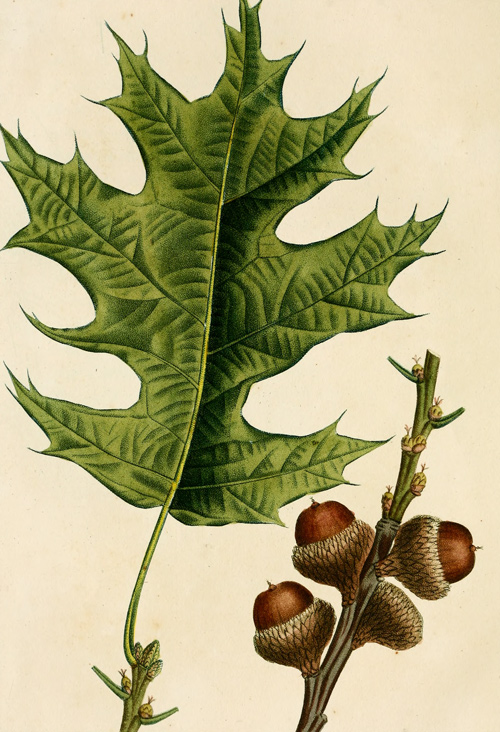In Pittsburgh, Meriwether Lewis is building the barge prior to departing down the Ohio River. The timber used for Ohio River shipbuilding was described by François André Michaux during his visit in 1802.
Black Oak Quercus tinctoria
Quercus velutina
From F. A. Michaux’s North American Sylva
François André Michaux, author; Augustus Lucas Hillhouse, translator; Pancrace Bessa, illustrator; Gabriel, engraver[1]The North American sylva, or A description of the forest trees of the United States, Canada and Nova Scotia . . . to which is added a description of the most useful of the European forest trees . . . … Continue reading
Timber for Building Ships
What many, perhaps, are ignorant of in Europe is, that they build large vessels on the Ohio, and at the town of Pittsburgh. One of the principal ship yards is upon the Monongahela, about two hundred fathoms beyond the last houses in the town. The timber they make use of is the white oak, or quercus alba; the red oak, or quercus rubra; the black oak, or quercus tinctoria; a kind of nut tree, or juglans minima; the Virginia cherrytree, or cerasus Virginia; and a kind of pine, which they use for masting, as well as for the sides of the vessels which require a slighter wood. The whole of this timber being near at hand, the expense of building is not so great as in the ports of the Atlantic states. The cordage is manufactured at Redstone and Lexinton, where there are two extensive rope-walks, which also supply ships with rigging that are built at Marietta and Louisville. (Michaux 160)
—François André Michaux[2]François André Michaux, Travels to the West of the Alleghany Mountains (1805 reprint from London edition), p. 63 in Reuben G. Thwaites, Travels West of the Alleghanies (Cleveland: The Arthur H. … Continue reading
François André Michaux
François André Michaux (1770-1855) should not be confused with his father André Michaux (1746–1802) whom Thomas Jefferson on behalf of the American Philosophical Society asked to lead a Western Expedition to the Pacific Ocean. Both were influential naturalists and both wrote about their travels in America. The younger’s writings show a keen interest in the prospects of the Ohio River Valley and its inhabitants. Later, he would publish his Histoire des Arbres forestiers de l’Amérique Septentrionale in three volumes between 1810 and 1813. It was translated into several English editions usually titled The North America Sylva. Thomas Nuttall completed the series with his volume North American Sylva: Trees not described by F. A. Michaux.[3]Thwaites, Travels, 15,19.
Experience the Lewis and Clark Trail
The Lewis and Clark Trail Experience—our sister site at lewisandclark.travel—connects the world to people and places on the Lewis and Clark Trail.
Plan a trip related to July 23, 1803:

Notes
| ↑1 | The North American sylva, or A description of the forest trees of the United States, Canada and Nova Scotia . . . to which is added a description of the most useful of the European forest trees . . . (Paris: C. D’Hautel, 1819), Plate 24; downloaded 28 November 2022 from the Biodiversity Heritage Library, www.biodiversitylibrary.org/bibliography/42243#/summary. |
|---|---|
| ↑2 | François André Michaux, Travels to the West of the Alleghany Mountains (1805 reprint from London edition), p. 63 in Reuben G. Thwaites, Travels West of the Alleghanies (Cleveland: The Arthur H. Clark Co., 1904), p. 160. |
| ↑3 | Thwaites, Travels, 15,19. |

